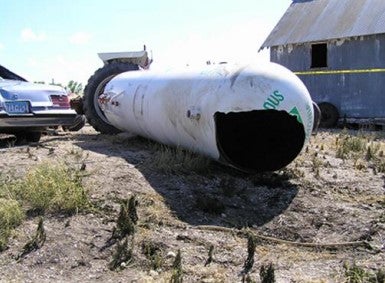WASHINGTON — Federal regulators “strongly recommend” that owners of certain types of hazardous chemical tanks conduct voluntary tests due to the potential for catastrophic failure based on new test results.
According to an advisory issued jointly by the Federal Motor Carrier Safety Administration and the Pipeline and Hazardous Materials Safety Administration, concern over the stability of “nurse tanks,” used typically to transport anhydrous ammonia over public roadways and farm fields, stems from an incident in August 2023 at a farm co-op lot.
Failure of a nurse tank manufactured by American Welding and Tank (AWT) “caused the tank shell to ‘rocket’ over 300 feet from its original location,” the agencies stated.
“While no injuries were reported, this event is an indicator of potential continuing problems with AWT nurse tanks that have now been in service for over a decade.”

AWT was not immediately available to comment.
After the incident, the owner of the tank contracted with a third-party testing company and found that seven of eight other nurse tanks it owned that were manufactured between 2008 and 2012 had extreme stress corrosion cracking.
The parent company of the farm co-op also conducted tests on 142 AWT nurse tanks manufactured between 2007 and 2012 and 100 failed the test. All 2012 tanks passed, according to FMCSA and PHMSA.
The advisory points out that current hazardous materials regulations do not require periodic inspection and testing of nurse tanks that have American Society of Mechanical Engineers (ASME) identification plates and meet other requirements. “Requirements for periodic inspection and testing of nurse tanks apply only when the ASME plate is missing or illegible,” the agencies stated.
However, “the FMCSA and PHMSA nevertheless strongly recommend that owners of AWT nurse tanks manufactured between January 1, 2007, and December 31, 2011 that are exempted from periodic inspection and testing requirements … conduct voluntary periodic visual inspection … thickness testing … and pressure testing” in accordance with federal regulations.
“For owners of affected AWT nurse tanks unable to conduct voluntary pressure testing, FMCSA and PHMSA recommend that either radiographic or ultrasonic testing be conducted. While the period of voluntary inspection and testing is at the discretion of the nurse tank owner, FMCSA and PHMSA recommend conducting the inspection and testing at least once every five years,” consistent with regulations.
The advisory stated that nurse tanks manufactured by AWT from 2009 to 2010 had been the subject of a prior FMCSA investigation and enforcement responding to improper manufacturing procedures.
A 2013 FMCSA study on nurse tank safety found that many of the reportedly 200,000 nurse tanks in use in the United States are 30 to 50 years old, and that several failures “caused extensive property damage, serious injuries, and death.”







